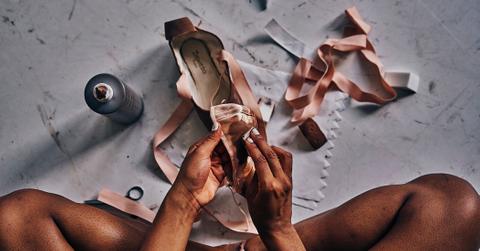
Cc: An Rong Xu for The New York Times
Ballet Pliés Into Inclusivity With The Creation Of Brown Pointe Shoes
By Patrice GillespieMay 30 2019, Published 6:31 p.m. ET
For centuries, Ballet was a profession that seemed to be whited out. In the 1820s, the first ballet pointe shoes were white, until pink shoes were curated with European dancers in mind. The first professional black ballerina, Raven Wilkinson, didn’t make her debut until the 1950s; even then she did so in someone else’s shoes. 200 years later and ballerinas of color are finally included in the conversation. In 2015, Misty Copeland was named the first Black woman to become the principal dancer at American Ballet Theatre. However, it was only in 2017 that pointe shoes were developed with ballerinas of color in mind.
According to an article by TODAY, many dancers of color had, and still have to partake in the act of pancaking their shoes. Ingrid Silva, a Brazilian born ballerina with the Dance Theatre of Harlem, discussed her personal struggles with being excluded and turning to pancaking;
“It’s part of my identity. It’s part of who I am. It’s part of who I represent. And it’s the look of our company,” Silva continues “But it’s a process that I wish that, if the brands pushed a little bit on their research, we didn’t have to (go through). Because it saves time. I could just wake up and put them on and dance, you know?”
Unfortunately, the lack of inclusivity in pointe shoes is just one of the many struggles dancers of color face. Misty Copeland sat down with TODAY to discuss some of the “underlying, subliminal messages that have been sent to people of color from the time ballet was created.” Copeland continues,
“When you buy pointe shoes or ballet slippers, and the color is called European pink, I think that it says so much to young people — that you don’t fit in, you don’t belong, even if it’s not being said.”
Uniformity is very important in ballet, and unfortunately, that is why many dance theatres are predominately white, and so are the shoes. Copeland blames this on the lack of opportunities available to people of color in their neighborhoods: “When you don’t have the means to be a part of it, or your community doesn’t have access to it, there’s not gonna be dancers that come in to be able to train.”
This conversation stretches beyond ballet into something deeper. Society has always chosen to paint the picture of acceptance in white. The whiter your skin, the more beautiful you were. The whiter your skin, the more educated you were considered to be. The whiter you were, the more likely you were to get a job; no matter how underqualified you were. However, just like in the world of Ballet, the picture of acceptance is receiving color in ranges it never has before.
“Representation matters a lot,” Silva said. “It feels empowering. It feels like you belong. It feels like dance is for everyone, and you can also be part of it.”
What might seem like one small step for society, is one large step for ballerinas of all colors across the globe.

